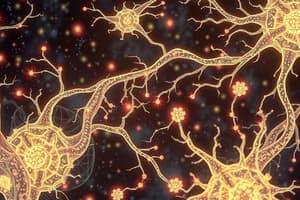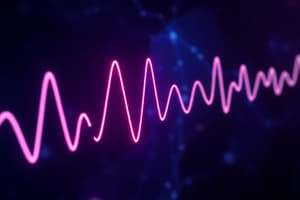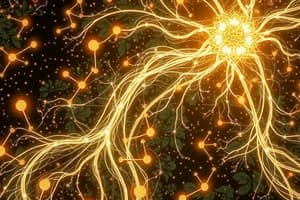Podcast
Questions and Answers
The resting potential is _____________ and nothing happens at this state.
The resting potential is _____________ and nothing happens at this state.
-70mV
What happens at the resting potential?
What happens at the resting potential?
Nothing
What is the trigger point of a neuron called?
What is the trigger point of a neuron called?
Threshold of excitation
What is fired after reaching the threshold of excitation?
What is fired after reaching the threshold of excitation?
Signup and view all the answers
Threshold of excitation is the level of _______________ (____________) necessary to generate an action potential.
Threshold of excitation is the level of _______________ (____________) necessary to generate an action potential.
Signup and view all the answers
What does hyperpolarization do to the resting membrane potential?
What does hyperpolarization do to the resting membrane potential?
Signup and view all the answers
What is IPSP?
What is IPSP?
Signup and view all the answers
Depolarization makes the neuron _____________.
Depolarization makes the neuron _____________.
Signup and view all the answers
What maintains the resting potential?
What maintains the resting potential?
Signup and view all the answers
On the outside of a cell, there are _____________ (____________) and _____________ (__________).
On the outside of a cell, there are _____________ (____________) and _____________ (__________).
Signup and view all the answers
On the inside of the cell, there are _____________ (__________) and _____________ (__________).
On the inside of the cell, there are _____________ (__________) and _____________ (__________).
Signup and view all the answers
Neurotransmission starts ______________ (Before the synapse): the threshold of excitation is reached and an _____________ fires.
Neurotransmission starts ______________ (Before the synapse): the threshold of excitation is reached and an _____________ fires.
Signup and view all the answers
After the action potential, ______________ (____________) enters the presynaptic terminal bouton.
After the action potential, ______________ (____________) enters the presynaptic terminal bouton.
Signup and view all the answers
The neurotransmitter crosses the synapse and attaches to a ___________ on the postsynaptic dendritic spine.
The neurotransmitter crosses the synapse and attaches to a ___________ on the postsynaptic dendritic spine.
Signup and view all the answers
Can neurotransmitters bind to any receptors?
Can neurotransmitters bind to any receptors?
Signup and view all the answers
Presynaptic terminal bouton: _____________ (_____________) enters the cell and causes vesicles to fuse to the membrane.
Presynaptic terminal bouton: _____________ (_____________) enters the cell and causes vesicles to fuse to the membrane.
Signup and view all the answers
There are __________ types of receptors: ______________ and ______________.
There are __________ types of receptors: ______________ and ______________.
Signup and view all the answers
Most neurotransmitters are dealt with by _____________ (recycling of neurotransmitters).
Most neurotransmitters are dealt with by _____________ (recycling of neurotransmitters).
Signup and view all the answers
The exception is ACh (Acetylcholine), which gets broken down by _____________.
The exception is ACh (Acetylcholine), which gets broken down by _____________.
Signup and view all the answers
Axons with myelin sheaths conduct ____________ than axons without myelin sheaths.
Axons with myelin sheaths conduct ____________ than axons without myelin sheaths.
Signup and view all the answers
Do dendrites have myelin sheaths?
Do dendrites have myelin sheaths?
Signup and view all the answers
The sodium-potassium pump (Na+ K+ pump): It resets the resting potential at -70mV.
The sodium-potassium pump (Na+ K+ pump): It resets the resting potential at -70mV.
Signup and view all the answers
The absolute refractory period means that a neuron ____________ generate an action potential.
The absolute refractory period means that a neuron ____________ generate an action potential.
Signup and view all the answers
The relative refractory period is when the neuron can generate an action potential but it requires ____________ of stimulation (EPSP).
The relative refractory period is when the neuron can generate an action potential but it requires ____________ of stimulation (EPSP).
Signup and view all the answers
Flashcards
Resting Potential
Resting Potential
The state of a neuron at approximately -70mV, where no action occurs.
Threshold of Excitation
Threshold of Excitation
The critical point around -65mV when a neuron can fire an action potential.
Hyperpolarization
Hyperpolarization
An increase in the negativity of the resting membrane potential.
IPSP
IPSP
Signup and view all the flashcards
Depolarization
Depolarization
Signup and view all the flashcards
EPSP
EPSP
Signup and view all the flashcards
Ionic Balance
Ionic Balance
Signup and view all the flashcards
Na+ and Cl-
Na+ and Cl-
Signup and view all the flashcards
K+ and A-
K+ and A-
Signup and view all the flashcards
Neurotransmission
Neurotransmission
Signup and view all the flashcards
Presynaptic Terminal Bouton
Presynaptic Terminal Bouton
Signup and view all the flashcards
Calcium Ions (Ca++)
Calcium Ions (Ca++)
Signup and view all the flashcards
Receptor Types
Receptor Types
Signup and view all the flashcards
Reuptake
Reuptake
Signup and view all the flashcards
Acetylcholine (ACh)
Acetylcholine (ACh)
Signup and view all the flashcards
Myelinated Axons
Myelinated Axons
Signup and view all the flashcards
Unmyelinated Axons
Unmyelinated Axons
Signup and view all the flashcards
Sodium-Potassium Pump
Sodium-Potassium Pump
Signup and view all the flashcards
Absolute Refractory Period
Absolute Refractory Period
Signup and view all the flashcards
Relative Refractory Period
Relative Refractory Period
Signup and view all the flashcards
Study Notes
Resting Potential
- Resting potential is approximately -70mV; no action occurs at this state.
- The threshold of excitation is the critical point for a neuron to fire, usually around -65mV.
- Hyperpolarization increases the negativity of the resting membrane potential.
- IPSP (Inhibitory Postsynaptic Potential) causes a neuron to become more negative, inhibiting firing.
- Depolarization decreases the resting membrane potential, making it more positive.
- EPSP (Excitatory Postsynaptic Potential) increases positivity, promoting action potential firing.
Ionic Balance
- Resting potential is maintained through ionic balance.
- Outside the cell: Na+ (sodium ions) and Cl- (chloride ions).
- Inside the cell: K+ (potassium ions) and A- (anions).
Neurotransmission Process
- Begins with reaching the threshold of excitation, leading to an action potential firing in the axon.
- Ca++ (calcium ions) enter the presynaptic terminal bouton, causing vesicles to release neurotransmitters into the synapse.
- Neurotransmitters bind to receptor sites on the postsynaptic dendritic spine, triggering postsynaptic potentials (IPSP or EPSP).
- Presynaptic autoreceptors detect neurotransmitter levels and regulate release by closing Ca++ channels.
- Receptors are specific; each type fits only certain neurotransmitters, akin to a lock and key design.
Presynaptic Terminal Bouton
- Ca++ entering the presynaptic terminal bouton facilitates neurotransmitter release into the synapse.
Receptor Types
- Two types of receptors on the postsynaptic side: Ionotropic and Metabotropic.
- Only Metabotropic autoreceptors exist on the presynaptic side.
Deactivation of Neurotransmitters
- Most neurotransmitters are deactivated through reuptake (recycling).
- ACh (Acetylcholine) is an exception, undergoing enzymatic degradation by acetylcholinesterase (AChE), which breaks it down and reassembles it for reuse.
Myelinated vs Unmyelinated Axons
- Axons with myelin sheaths conduct signals faster than those without.
- Dendrites lack myelin sheaths entirely; only axons are myelinated.
Sodium-Potassium Pump
- The sodium-potassium pump resets the resting potential at -70mV after action potential firing and hyperpolarization.
- It actively pumps 3 Na+ ions out for every 2 K+ ions taken in.
- The absolute refractory period occurs when a neuron cannot generate another action potential due to hyperpolarization.
- The relative refractory period follows, during which an action potential can occur but requires increased stimulation (EPSP).
Studying That Suits You
Use AI to generate personalized quizzes and flashcards to suit your learning preferences.
Description
Prepare for your Exam III in Physiological Psychology with these flashcards. This set focuses on key concepts such as resting potential, action potentials, and the threshold of excitation. Enhance your understanding of neuronal functions and prepare effectively for your exam.




